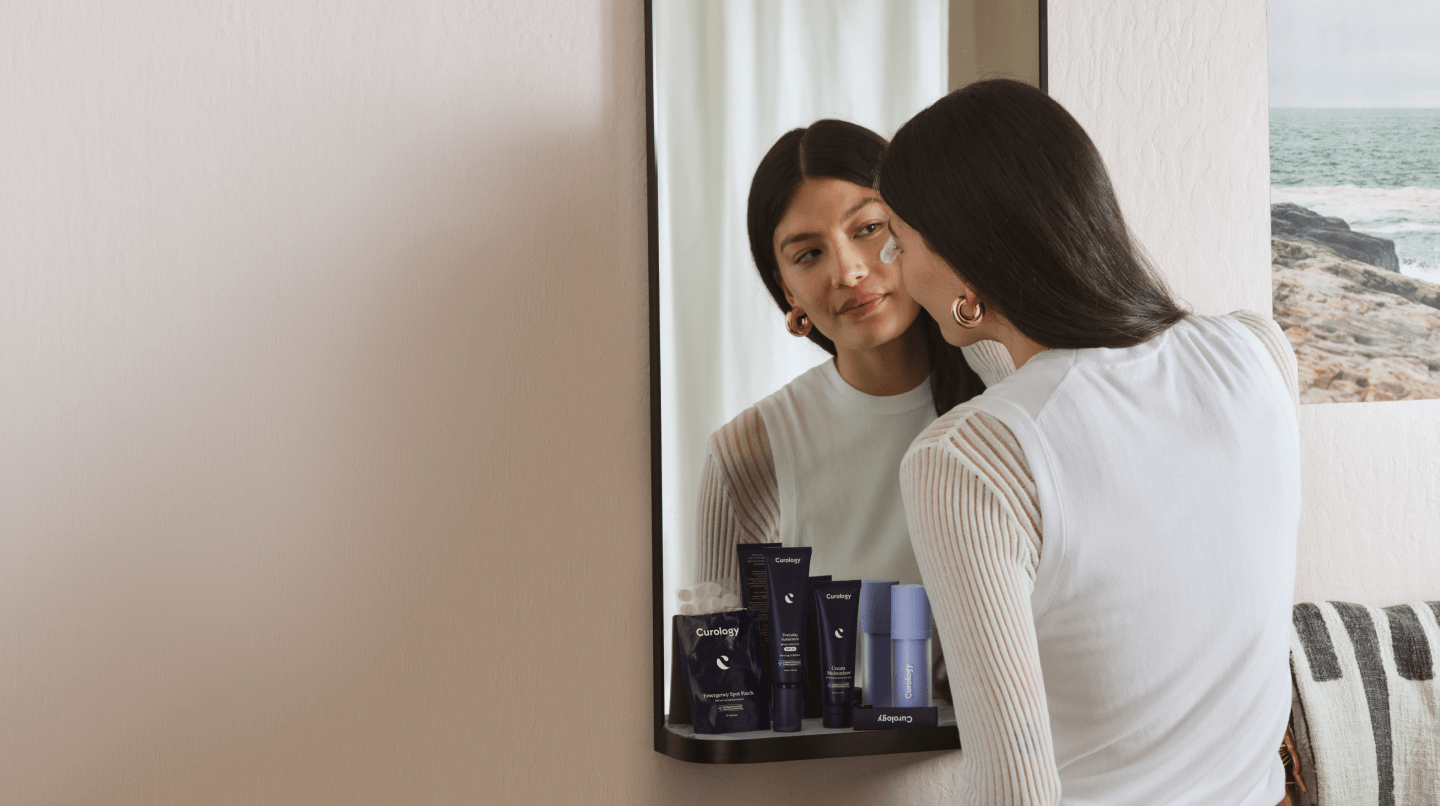How it works:
Share your skin goals and snap selfies
Your dermatology provider prescribes your formula
Apply nightly for happy, healthy skin
How it works:
How it works:
Share your skin goals and snap selfies
Your dermatology provider prescribes your formula
Apply nightly for happy, healthy skin
How it works:
Adding tretinoin to your routine?
Take our skin quiz before you start!
10 tips for using tretinoin in a skincare routine
Some call it the gold standard topical ingredient for acne and anti-aging skin issues—but it can take time for your skin to get used to it.





The key takeaways
Tretinoin is a popular prescription-strength retinoid used to treat acne and help reduce the visible signs of aging.
Using too much too soon can leave your skin dry, itchy, flaky, or red—but a little irritation when you first start is common and expected.
Topical tretinoin helps increase cell turnover and boost collagen production.¹ You may begin to see results after one month, but it can take up to a year to see its full effect. Continued results may be seen with prolonged use.
Receiving skincare essentials and a personalized prescription formula tailored to help meet your skin goals is easy with Curology. You’ll also have access to a licensed dermatology provider with experience treating people with tretinoin.
Your skin may need time to adjust when you start using prescription retinoids like tretinoin. We know you’re anxious to see results—but, unfortunately, skin doesn’t work that way. Curology’s licensed dermatology providers have created this guide to help you learn more about tretinoin.
What is tretinoin?
Tretinoin is a prescription-strength vitamin A derivative, typically formulated as a cream or gel. Tretinoin works by speeding up cell turnover.² This helps prevent and clear clogged pores. Tretinoin is a topical retinoid, which is one of the most effective products against acne and visible signs of aging.
Looking for the ideal dose of tretinoin for your skin goals? Get started with your custom formula today.*
What is the difference between tretinoin and retinol?
Retinol and tretinoin are topical retinoid compounds or vitamin A derivatives. Some people choose over-the-counter retinol. But you should understand your options before making a decision.
Tretinoin is only available with a prescription³, and is generally considered stronger and more effective than over-the-counter retinol. Retinol is available over the counter, and may be less likely to have side effects such as redness and burning sensation than with tretinoin.⁴ However, it must first be converted to retinoic acid, while tretinoin is in a form that interacts with the skin immediately.⁵ Retinol may help prepare your skin for tretinoin, so the transition to a prescription strength topical retinoid may be easier if you’re already using retinol in your skincare routine.

How does tretinoin work on your skin?
Tretinoin works under the skin surface to help prevent clogged pores and regulate cell turnover.⁶ Although skin regeneration happens naturally, this process slows as you age.⁷
Curology’s licensed dermatology provider, Elise Griffin, PA-C, explains, “Tretinoin is generally considered to be the gold standard topical treatment for both acne and anti-aging concerns. It can help prevent clogged pores, improve skin texture, reduce fine lines, and improve certain dark spots.”
Recently, tretinoin has been used in combination with antibacterials like benzoyl peroxide and clindamycin to create topical treatments with antibacterial, comedolytic, and anti-inflammatory properties.⁸⁻⁹
Having fewer dead skin cells may improve the appearance of dry, rough, and aging skin. Tretinoin promotes collagen production, which helps give the skin a smoother, more even texture.¹⁰ It also improves hyperpigmentation, i.e., sunspots and post-inflammatory hyperpigmentation.
Skin benefits of tretinoin
When looking for a strategy to help improve the quality and appearance of your skin, tretinoin may be your answer. Discuss how tretinoin can help benefit your skin care regimen with your Curology** dermatology provider or other healthcare provider.
Tretinoin is used to treat acne, reduce dark spots, boost collagen production, and reduce the visible appearance of aging, including fine lines and wrinkles.¹¹ Tretinoin is capable of treating your acne and boosting your collagen production simultaneously, likely resulting in clearer, brighter, and smoother skin.
Reduces acne
Even mild acne outbreaks can have a significant impact on emotions, social activities, and interpersonal relationships.¹² Tretinoin can help reduce this negative impact of acne.

Reduces dark spots
Localized hyperpigmentation—dark spots—is commonly the result of sun damage and often appears in highly visible areas such as the face, neck, and back of the hands.¹³

Boosts collagen production
Collagen provides support to healthy skin and preserves skin firmness and elasticity.¹⁴
Reduces fine lines and wrinkles
Fine lines and wrinkles are a natural part of aging that can be caused by hormonal changes, disease, smoking, sun damage, and aging.¹⁵

Integrating tretinoin into your skincare routine
Elise Griffin, PA-C, shares her clinical experience: “When tretinoin is first started, irritation, dryness, or burning can be normal as the skin adjusts. After a few weeks, these symptoms should start to improve. When adjusting to tretinoin, it is generally recommended to start out by using it 2-3 nights per week, then gradually increasing use as tolerated. When I was adjusting to tretinoin, I would always apply moisturizer first to help minimize potential irritation or dryness. It’s important to follow your dermatology provider’s advice and reach out to them with any symptoms you may experience as you adjust!”
Tretinoin side effects
Further, Elise explains that some “may experience an initial breakout when starting tretinoin, which is often referred to as “purging.” This can be common, however, some may not experience this at all! Over time, the skin will start to improve. It’s important to remember that this period is temporary! Reach out to your dermatology provider for specific advice to help if you experience this.”
Other potential side effects of tretinoin include redness, skin peeling, and sensitivity to the sun.¹⁶ Follow your licensed dermatology provider’s instructions so your skincare routine is more comfortable. Contact your healthcare professional if the skin irritation becomes severe or you develop hives or facial swelling.
How long does it take to see results from tretinoin?
Tretinoin is generally not fast-acting, but can be effective and deliver long-lasting results with consistent use.
You will likely notice a difference in your acne within the first six to eight weeks. However, when you are looking for anti-aging benefits the length of time it takes to see improvements can vary from as little as a few weeks to one year.
Expert tips on using tretinoin in skincare treatment
Here are 10 of our top tips for easing tretinoin into your skincare routine. It’s important to remember to always follow the instructions of your prescribing medical provider and reach out to them if you have questions about your treatment or need advice.
1. Cleanse and wait 10-20 minutes before applying tretinoin
Cleanse your face with a quality mild cleanser, ideally one developed for your skin type. Pat your face dry and wait 10-20 minutes before applying tretinoin as instructed by your medical provider. Never apply it on damp or wet skin because it can absorb quickly and cause skin irritation.
2. Start small and increase slowly
When you first start using tretinoin, you may start with a lower percentage that you apply just two or three times a week. After two weeks, if your skin is adjusting well to the tretinoin, you can consider increasing use to every night as tolerated. Of course, check with your dermatology provider first!
3. Ensure proper application of tretinoin
To get the most out of this effective treatment, apply as directed by your medical provider. Generally speaking, the cream or gel is applied to clean, dry skin. Remember that a little bit goes a long way! Most people need just a pea-sized amount of tretinoin for their face and neck. Before using, apply an occlusive cream or Vaseline around your eyes and the corners of your mouth to protect the skin.
Remember not to over-apply or mix tretinoin with other drying agents. Instead, use your other products in the morning and tretinoin at night, and discuss your skincare routine with your licensed dermatology provider.
4. Make it a part of your nighttime routine
Always apply your tretinoin at night because UV light can make it less effective. Applying tretinoin at night may give your skin cells the maximum benefit, not only because it helps you avoid the reaction with sunlight, but because skin permeability is increased at night.¹⁷
5. Integrate it in with your other products
Complement your routine by including other skincare products in your AM routine to help you reach your skincare goals. Examples include a vitamin C serum for its anti-aging benefits¹⁸ or hyaluronic acid for its hydrating properties.¹⁹ If you’re a Curology member, your Curology dermatology provider may also prescribe you a tretinoin cream with other active ingredients to help tackle your concerns from multiple angles.
Get your personalized skincare routine with Curology
Get your personalized skincare routine with Curology


6. Commit to daily sun protection
Tretinoin may make your skin more sensitive to the sun.²⁰ Commit to wearing sunscreen with SPF 30 or higher every day. Sun protection is non-negotiable, including during the winter months. Remember, the best sun protection is the one you’ll use every day!
7. Stop using other harsh products
Tretinoin is a powerful acne-fighting and anti-aging ingredient. Mixing this prescription-strength product with other harsh products, such as exfoliating acids, may trigger severe skin irritation enough that you may have to stop treatment until your skin heals.²¹ You can expect some dryness or light peeling.
8. If your skin is irritated, buffer with moisturizer
Tretinoin may cause irritation and dryness as you adjust. You can help protect your skin with a layer of moisturizer before applying the tretinoin. This generally doesn’t reduce the effectiveness of the medication, but can help to soothe and moisturize the skin. Check with your dermatology provider to see if this may be right for you!
9. Reduce your percentage if necessary
You might think that more is better, but with tretinoin, starting small and slow is typically the preferred method. When your skin tells you it needs more time and less medication, you may want to consider talking to your medical provider about reducing the percentage. Symptoms include increasing redness, scaling, and peeling.²�² If tretinoin is appropriate for you, a Curology licensed dermatology provider can prescribe a personalized formula with a percentage based on your preferences and previous experience with tretinoin and can adjust the strength if needed.
10. Be patient and don’t quit too soon
It would be nice if the results appeared within days, but unfortunately, they don’t! It’s important to be patient and wait for at least 12 weeks to see how tretinoin can help reduce your acne.²³ If you quit too soon, you’ll never know if tretinoin may have been the answer you were searching for.
Curology and tretinoin
One of the easiest ways to get prescription skin care is through Curology. We’re a telehealth service that pairs our members with licensed dermatology providers. They work with you to help you get the right products for your unique skin.

Getting started* with Curology is easy. Just take a quick quiz and snap a few selfies. We’ll review your skin concerns and prescribe a personalized formula for your concerns. You can choose to pair that with Curology’s gentle cleanser, moisturizer, and any other product your dermatology provider thinks might benefit your skin. We believe in personalized service, from customized prescription formulas to expert guidance. If you have questions, we want you to ask!
FAQs
You should NOT:
Apply tretinoin to damp skin since this may increase skin irritation.
Apply during the daytime, since the sunlight makes the medication less effective.
Overuse the medication since it can lead to redness, dryness, and peeling.
Go outside without sun protection.
Mix tretinoin with incompatible products.
Give up too soon! It can take up to 8 weeks or more for acne to begin clearing and several months for anti-aging effects to show.
We understand the frustration of dealing with acne or waiting for the anti-aging effects to show. However, the benefits of tretinoin are well worth the wait. If you do try to speed up the results, you’ll likely increase your risk of severe side effects and will have to stop treatment for several weeks until your skin heals.
This depends on your skin and how it reacts to tretinoin. You can begin treatment by applying to clean dry skin. If you notice increasing dryness or slight redness, you can apply moisturizer before applying tretinoin and after or you can mix moisturizer with tretinoin. Talk to your Curology licensed dermatology provider for advice about your skin.
Generally speaking, let tretinoin absorb and fully dry before applying moisturizer. However, if you and your licensed dermatology provider decide your skin needs more moisturizer, you can alter the application to meet your needs.
Maybe! The under-eye skin is much more sensitive than the rest of the face. Some people cannot tolerate tretinoin near the eyes. Before using in this area, discuss with your dermatology provider for tips to see if it works for you.
Generally speaking, you may begin by applying tretinoin twice a week and increase the frequency as your skin adjusts to the medication. Your Curology licensed dermatology provider can help you adjust the application schedule. Always be sure to follow the instructions of your medical provider.
Your Curology licensed dermatology provider will advise you where you should apply the tretinoin cream or gel. However, it is generally advised to avoid application of tretinoin near the eyes, the creases of the nose, and around the lips.
Symptoms of tretinoin burn include significant redness, dryness, itchiness, and peeling. These symptoms typically resolve without treatment. However, speak with your Curology licensed dermatology provider or healthcare provider to determine if you should reduce the strength of the medication or the frequency of application.
P.S. We did the homework so you don’t have to:
Zasada, M. and Budzisz, E. Retinoids: active molecules influencing skin structure formation in cosmetic and dermatological treatments. Advances in Dermatology and Allergology. (August 2019).
Zasada, M. and Budzisz, E. Retinoids: active molecules influencing skin structure formation in cosmetic and dermatological treatments. Advances in Dermatology and Allergology. Ibid.
U.S. Food & Drug Administration. Highlights of Prescribing Information Retin-A Micro (tretinoin) Gel microsphere 0.1%, 0.08% and 0.04% for topical use. (January 2014).
Bouloc, A., et al. A double-blind randomized study comparing the association of Retinol and LR2412 with tretinoin 0.025% in photoaged skin. Journal of Cosmetic Dermatology. (2015, January 21).
Zasada, M. and Budzisz, E. Retinoids: active molecules influencing skin structure formation in cosmetic and dermatological treatments. Advances in Dermatology and Allergology. Ibid.
Baldwin, H.E., et al. 40 Years of Topical Tretinoin Use in Review. Journal of Drugs in Dermatology. (June 2013).
Khalid, K.A. et al. Aging and Wound Healing of the Skin: A Review of Clinical and Pathophysiological Hallmarks. Life (Basel). (December 2022).
Feneran, A.N., et al. Retinoid plus antimicrobial combination treatments for acne. Clinical, Cosmetic and Investigational Dermatology. (2011, July 1).
Dogra, S., et. al. Efficacy and safety comparison of combination of 0.04% tretinoin microspheres plus 1% clindamycin versus their monotherapy in patients with acne vulgaris: a phase 3, randomized, double-blind study. Journal of Dermatological Treatment. (2020, February 5).
Griffiths, C., et al. Restoration of Collagen Formation in Photodamaged Human Skin by Tretinoin (Retinoic Acid). New England Journal of Medicine. (August 1993).
Yoham, A.L. and Casadesus, D. Tretinoin. StatPearls. (2023, March 27).
Hazarika, N. and Archana, N. The Psychosocial Impact of Acne Vulgaris. Indian Journal of Dermatology. (September-October 2016).
Desai, S.R. Hyperpigmentation Therapy: A Review. The Journal of Clinical and Aesthetic Dermatology. (August 2014).
Reilly, D.M. and Lozano, J. Skin collagen through the life stages: importance for skin health and beauty. Plastic and Aesthetic Research. (January 2021).
Manriquez, J.J., et. al. Wrinkles. BMJ Clinical Evidence. (2014, December 22).
Yoham, A.L. and Casadesus, D. Tretinoin. StatPearls. Ibid.
Lyons, A.B., et al. Circadian Rhythm and the Skin: A Review of the Literature. The Journal of Clinical and Aesthetic Dermatology. (September 2019).
Al-Niami, F. and Chiang, N.Y.Z. Topical Vitamin C and the Skin: Mechanisms of Action and Clinical Applications. J Clin Aesthet Dermatol. (2017, July 1).
Draelos, Z.D., et al. Efficacy Evaluation of a Topical Hyaluronic Acid Serum in Facial Photoaging. Dermatol Ther (Heidelb). (August 2021).
Yoham, A.L. and Casadesus, D. Tretinoin. StatPearls. Ibid.
Obagi Cosmeceuticals LLC. Tretinoin Cream - Drug Label Information. DailyMed National Library of Medicine. (January 2019).
Bouloc, A., et al. A double-blind randomized study comparing the association of Retinol and LR2412 with tretinoin 0.025% in photoaged skin. Journal of Cosmetic Dermatology. Ibid.
Leyden, J., et al. Why Topical Retinoids Are Mainstay of Therapy for Acne. Dermatology and Therapy. (September 2017).
* Subject to consultation. Subscription is required. Results may vary. Restrictions apply. See website for full details and important safety information. ** Ingredients subject to medical consultation. Inform your medical providers about pregnancy status
Erin Pate is a board-certified Family Nurse Practitioner at Curology. She earned her Masters of Science in Nursing at Florida Atlantic University in Boca Raton, FL.
Elise Griffin is a certified physician assistant at Curology. She received her Master of Medical Science in physician assistant studies from Nova Southeastern University in Jacksonville, FL.

Curology Team

Erin Pate, NP-C
Related Articles
How to use acne body wash correctly: Your straightforward guideMen skin care: top concernsHow to get rid of body and back acne?Sunscreen for eyes: How to protect your delicate skin from UV raysFoundation makeup for aging skinPopular Articles
Ask Curology: Is my cold breaking me out?Slugging: The dermatologist-approved skincare hack going viral on TikTokTretinoin vs retinol: What’s the difference?How to create a self-care routine that actually sticksYour 2023 skincare horoscopeTry prescription skincare
Get routine essentials


Face what’s next with Future-ProofRx
Face what’s next with Future-ProofRx
- Skin texture
- Fine lines
- Wrinkles
- Dark spots
- Dullness
$29.95/month